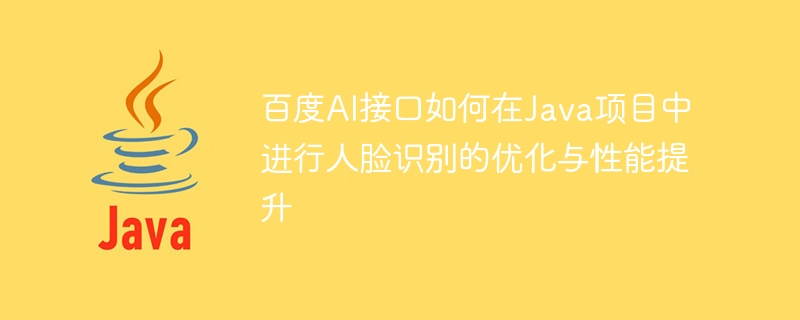

How Baidu AI interface optimizes and improves the performance of face recognition in Java projects
Introduction:
In today's society, the application of face recognition technology The scope is increasingly broad. As one of the leaders in face recognition technology, Baidu AI provides a series of powerful face recognition interfaces to facilitate developers to develop face recognition applications in Java projects. However, in order to ensure the accuracy and performance of face recognition, we need to optimize the call of Baidu AI interface. This article will introduce how to optimize the Baidu AI interface in a Java project to improve the performance of face recognition.
1. Using Baidu AI SDK
Baidu AI provides Java SDK, and we can directly use this SDK to call the face recognition interface. When using the SDK, we need to provide Baidu AI's API Key and Secret Key, and considering security issues, it is best to store this sensitive information in the configuration file.
The sample code is as follows:
// 使用百度AI SDK进行人脸识别接口调用
// 导入必要的包
import com.baidu.aip.face.AipFace;
import org.json.JSONObject;
import java.util.HashMap;
public class FaceRecognition {
// 配置百度AI的API Key和Secret Key
private static final String APP_ID = "your_app_id";
private static final String API_KEY = "your_api_key";
private static final String SECRET_KEY = "your_secret_key";
public static void main(String[] args) {
// 初始化AipFace对象
AipFace client = new AipFace(APP_ID, API_KEY, SECRET_KEY);
// 设定请求参数
HashMap<String, String> options = new HashMap<>();
options.put("face_field", "age,gender");
options.put("max_face_num", "2");
// 调用人脸检测接口
JSONObject result = client.detect("your_image_path", options);
// 处理返回结果
System.out.println(result.toString(2));
}
}2. Batch processing of face data
In order to improve the performance of face recognition, we can use multi-threading or asynchronous mechanism to batch process face data . For example, we can divide the face pictures that need to be recognized into multiple batches, and assign each batch to a different thread or task for processing. This can improve the efficiency of concurrent processing and speed up face recognition.
The sample code is as follows:
import java.util.concurrent.ExecutorService;
import java.util.concurrent.Executors;
import java.util.concurrent.TimeUnit;
public class FaceRecognitionBatch {
public static void main(String[] args) {
// 创建线程池,设置线程数量
ExecutorService executor = Executors.newFixedThreadPool(10);
// 假设人脸图片存储在一个列表中
List<String> imagePaths = new ArrayList<>();
// 添加人脸图片路径到列表中
// 分批处理人脸图片
int batchSize = 10;
for (int i = 0; i < imagePaths.size(); i += batchSize) {
List<String> batchImagePaths = imagePaths.subList(i, Math.min(i + batchSize, imagePaths.size()));
executor.execute(new FaceRecognitionTask(batchImagePaths));
}
// 关闭线程池
executor.shutdown();
try {
executor.awaitTermination(Long.MAX_VALUE, TimeUnit.NANOSECONDS);
} catch (InterruptedException e) {
e.printStackTrace();
}
}
}
class FaceRecognitionTask implements Runnable {
private List<String> imagePaths;
public FaceRecognitionTask(List<String> imagePaths) {
this.imagePaths = imagePaths;
}
@Override
public void run() {
AipFace client = new AipFace(APP_ID, API_KEY, SECRET_KEY);
// 设置其他参数
for (String imagePath : imagePaths) {
// 调用百度AI接口进行人脸识别
// 处理返回结果
}
}
}This sample code shows how to use the thread pool to batch process face data, which can be adjusted according to the actual situation.
3. Cache interface call results
When performing face recognition on pictures, you may encounter the situation where the face recognition interface is called multiple times for the same picture. In order to reduce unnecessary interface calls, we can use a caching mechanism to save the results of interface calls. When face recognition is requested again for the same picture, the results are obtained directly from the cache without making any interface calls.
The sample code is as follows:
import java.util.HashMap;
import java.util.Map;
public class FaceRecognitionCache {
private static Map<String, JSONObject> cache = new HashMap<>();
public static JSONObject getFromCache(String key) {
return cache.get(key);
}
public static void saveToCache(String key, JSONObject result) {
cache.put(key, result);
}
}Before calling the face recognition interface, we can first query whether there are already calculated results from the cache. If it exists, the result in the cache is used directly. Otherwise, make a call to the face recognition interface and save the result to the cache.
// 从缓存中获取结果
JSONObject result = FaceRecognitionCache.getFromCache(imagePath);
if (result != null) {
// 直接使用缓存中的结果
// 处理返回结果
} else {
// 调用百度AI接口进行人脸识别
// 处理返回结果
// 将结果保存到缓存中
FaceRecognitionCache.saveToCache(imagePath, result);
}Through the caching mechanism, repeated interface calls can be avoided and the speed and performance of face recognition can be improved.
Conclusion:
This article introduces how to optimize the face recognition performance of Baidu AI interface in Java projects. By using Baidu AI SDK, batch processing of face data and caching interface call results, the speed and efficiency of face recognition can be improved. I hope this article will be helpful to developers in developing face recognition applications in Java projects.
The above is the detailed content of How Baidu AI interface optimizes and improves the performance of face recognition in Java projects. For more information, please follow other related articles on the PHP Chinese website!




